

|
| ESPAÑA | Spain |
| Castilla y León | Castile and León |
| Provincia: Segovia | Segovia |
Real Sitio de San Ildefonso (La Granja de San Ildefonso, La Granja) is a town and municipality in the Province of Segovia, in the Castile and León autonomous region of central Spain. It is situated at an elevation of 1,193 m in the foothills of the Sierra de Guadarrama mountains, 11 kilometres from Segovia, and 80 kilometres north of Madrid. The municipality has a population of about 5,700 (2010). The town and the La Granja palace are a popular tourist attraction.
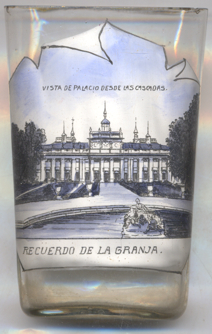
The  Royal Palace of La Granja de San Ildefonso [left, no. 3513] is a
royal palace and gardens built adjacent to the town in 1721–1724. It was commissioned by King Felipe (Philip) V of Spain,
and designed in the Spanish and French Baroque styles. It was modeled on the Palace of Versailles, which was built by Philip’s
grandfather Louis XIV of France, and has been called the “Versailles of Spain”. The palace is set in extensive
gardens designed in the ‘Jardin à la française’ style, the epitome of which are the Gardens of Versailles, and beyond
those surrounded in English landscape style gardens and woodlands. For the next two hundred years, La Granja was the
court’s main summer palace, until the Second Spanish Republic was formed in 1931.
The royal site is part of the Patrimonio Nacional of Spain, which holds and maintains many of the Crown’s lands and palaces.
It is a popular tourist attraction, with paintings, portraits, and a museum of Flemish tapestries.
Royal Palace of La Granja de San Ildefonso [left, no. 3513] is a
royal palace and gardens built adjacent to the town in 1721–1724. It was commissioned by King Felipe (Philip) V of Spain,
and designed in the Spanish and French Baroque styles. It was modeled on the Palace of Versailles, which was built by Philip’s
grandfather Louis XIV of France, and has been called the “Versailles of Spain”. The palace is set in extensive
gardens designed in the ‘Jardin à la française’ style, the epitome of which are the Gardens of Versailles, and beyond
those surrounded in English landscape style gardens and woodlands. For the next two hundred years, La Granja was the
court’s main summer palace, until the Second Spanish Republic was formed in 1931.
The royal site is part of the Patrimonio Nacional of Spain, which holds and maintains many of the Crown’s lands and palaces.
It is a popular tourist attraction, with paintings, portraits, and a museum of Flemish tapestries.
Three important international treaties between Spain and France or Portugal bear the name Treaty of San Ildefonso. They were each
negotiated and signed at La Granja palace between 1777 and 1800.
The First Treaty of San Ildefonso (1777) between the Spanish Empire and the Portuguese Empire
settled territorial disputes in the Río de la Plata region; based on the terms of the agreement, Spain ceded territories in Brazil
to Portugal (i.e. the Amazon Basin) in return for maintaining control over the Banda Oriental (i.e. Uruguay).
The Second Treaty of San Ildefonso (1796) was a contract between Spain and the First French Republic; based on the terms of the
agreement, France and Spain would become allies and combine their forces against the British Empire.
The Third Treaty of San Ildefonso (1800) was a treaty between France and Spain in which Spain returned the colonial territory of
Louisiana to France; the terms of the treaty did not specify the boundaries of the territory being returned, which later became
a point of contention between Spain and the United States after the Louisiana Purchase in 1803 (see
map), in which France sold its territory to the United States.
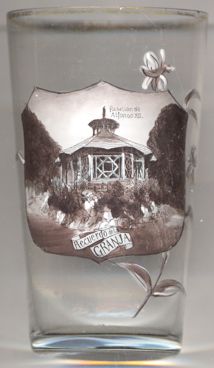
The  Pabellón de Alfonso XIII or Merendero del Huertecillo [left, no. 4507]
was built of wood with a broom roof on a small mound in the palace gardens. The pavillon was dismantled at an unknown date. Of it,
only the mound covered in rich vegetation and some parts of the cobblestone landing on top of it and some semi-hidden steps have remained. The name
refers to Alfonso XIII, King of Spain from his birth in 1886 until 1931, when the Second Spanish Republic was proclaimed. He became a monarch
at birth as his father, Alfonso XII, had died the previous year. Alfonso's mother, Maria Christina of Austria, served as regent until he assumed
full powers on his sixteenth birthday in 1902.
Pabellón de Alfonso XIII or Merendero del Huertecillo [left, no. 4507]
was built of wood with a broom roof on a small mound in the palace gardens. The pavillon was dismantled at an unknown date. Of it,
only the mound covered in rich vegetation and some parts of the cobblestone landing on top of it and some semi-hidden steps have remained. The name
refers to Alfonso XIII, King of Spain from his birth in 1886 until 1931, when the Second Spanish Republic was proclaimed. He became a monarch
at birth as his father, Alfonso XII, had died the previous year. Alfonso's mother, Maria Christina of Austria, served as regent until he assumed
full powers on his sixteenth birthday in 1902.
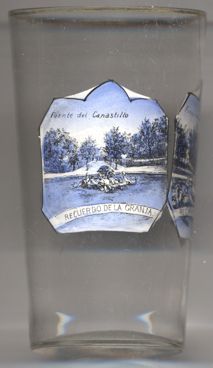
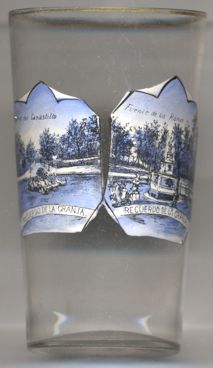
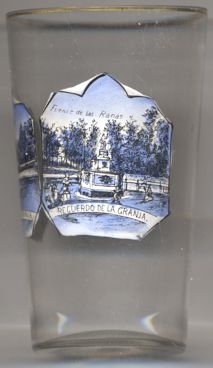
The  Fuente del Canastillo [near left, no. 4507: left picture] is not a particularly spectacular
structure as such, but its more than 70 water jets and four different features make it one of the most anticipated by visitors. The monument
consists of a basket full of fruits surrounded by four naiads. The water of this fountain comes directly from the El Mar pond. It has a large
vertical jet and several smaller ones around at the top of the Canastillo, around it there are 42 jets that point outwards and, if the vertical jets
are turned off, the lateral ones go up to six meters outside the pylon, wetting the spectators.
Fuente del Canastillo [near left, no. 4507: left picture] is not a particularly spectacular
structure as such, but its more than 70 water jets and four different features make it one of the most anticipated by visitors. The monument
consists of a basket full of fruits surrounded by four naiads. The water of this fountain comes directly from the El Mar pond. It has a large
vertical jet and several smaller ones around at the top of the Canastillo, around it there are 42 jets that point outwards and, if the vertical jets
are turned off, the lateral ones go up to six meters outside the pylon, wetting the spectators.
The  Fuente de Leto, better known as Fuente de Las Ranas [near left, no. 4507: right picture],
It has more than 60 water jets and has its own tank for its operation. The fountain tells the mythological story of Leto, mother of Apollo and Artemis,
when she felt thirsty during her pilgrimage and asked the Lycian farmers to give them water. Not only did they not give it to her, but they also muddied
the water in the lake. As punishment, Leto turned them into frogs.
Fuente de Leto, better known as Fuente de Las Ranas [near left, no. 4507: right picture],
It has more than 60 water jets and has its own tank for its operation. The fountain tells the mythological story of Leto, mother of Apollo and Artemis,
when she felt thirsty during her pilgrimage and asked the Lycian farmers to give them water. Not only did they not give it to her, but they also muddied
the water in the lake. As punishment, Leto turned them into frogs.
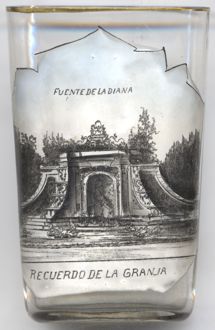
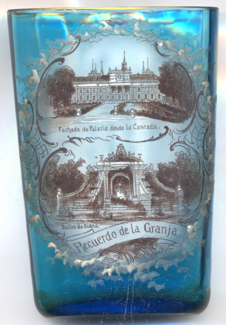
The  Fuente de los Baños de Diana [left, no. 4574, and right, no. 3001: bottom picture],
a fountain in the focal point of several alleys of the palace gardens, is made of lead painted to look like bronze and marble
and was created between 1720 and 1745 by Huberto Dumandré and Pedro Pitué using plans by Santiago Bousseaux. The fountain and its
marble statues form some of the most impressive and well conserved architecture from this period in Spain. However, according to a
popular anecdote, Felipe V commented “It has cost me three millions and amused me three minutes.”
Fuente de los Baños de Diana [left, no. 4574, and right, no. 3001: bottom picture],
a fountain in the focal point of several alleys of the palace gardens, is made of lead painted to look like bronze and marble
and was created between 1720 and 1745 by Huberto Dumandré and Pedro Pitué using plans by Santiago Bousseaux. The fountain and its
marble statues form some of the most impressive and well conserved architecture from this period in Spain. However, according to a
popular anecdote, Felipe V commented “It has cost me three millions and amused me three minutes.”
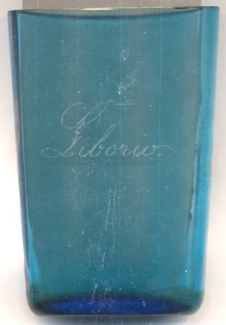
The back side of glass no. 3001 [right] is engraved “Liborio”.
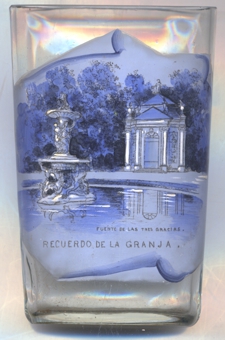
The  Fuente
Fuente
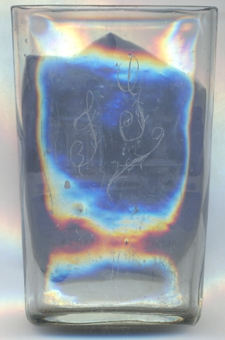
The back side of glass no. 3032 [left] is engraved with the initials “J S”.
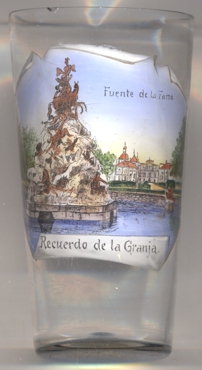
The  Fuente de la Fama [near left, no. 3033]
is located on the west side of the palace. Like the Bath of Diana, the Fountain of Fame also was designed by Huberto Dumandré
and Pedro Pitué. On top of a six-metre-high rock, Fame, mounted on Pegasus, is playing
her flute, from which — when the fountain is operating — a jet of water rises
to a height of more than 42 metres. The horse is treading four warriors representing envy, meanness, wickedness and ignorance.
The fountain has 21 jets that consume 360 liters per second and can work for only 10 minutes as the smaller suppliers
quickly consume the waters of the Ocho Calles reservoir.
Fuente de la Fama [near left, no. 3033]
is located on the west side of the palace. Like the Bath of Diana, the Fountain of Fame also was designed by Huberto Dumandré
and Pedro Pitué. On top of a six-metre-high rock, Fame, mounted on Pegasus, is playing
her flute, from which — when the fountain is operating — a jet of water rises
to a height of more than 42 metres. The horse is treading four warriors representing envy, meanness, wickedness and ignorance.
The fountain has 21 jets that consume 360 liters per second and can work for only 10 minutes as the smaller suppliers
quickly consume the waters of the Ocho Calles reservoir.
The original waterworks and piping of the fountains are still functional. They rely purely on gravity to project water up the
fountain jets, including to the 40 metres height of the “Fame” fountain. A reservoir, “El Mar”
(the Sea), lies secluded at the highest point of the landscape park, and provides the supply and water pressure for the whole system.
In the present day, only a few fountains are active on each day.
All 26 monumental fountains are put in operation three times a year, for the
festivities of San Fernando (30 May), Santiago (25 July) and San Luis (25 August).
[https://en.wikipedia.org/wiki/San_Ildefonso; https://en.wikipedia.org/wiki/Royal_Palace_of_La_Granja_de_San_Ildefonso;
https://es.wikipedia.org/wiki/Palacio_Real_de_la_Granja_de_San_Ildefonso;
https://en.wikipedia.org/wiki/First_Treaty_of_San_Ildefonso; https://en.wikipedia.org/wiki/Second_Treaty_of_San_Ildefonso;
http://www.segoviaturismo.es/files/pdf/20120529151727e3b1757b6d345eb66867c9a5c7f03e56.pdf,
http://www.fotoviajero.com/en/tags/parks-and-gardens/fountain-of-the-three-graces_1904,
https://en.wikipedia.org/wiki/Charites;
https://www.acueducto2.com/jardines-y-bosque-del-palacio-de-la-granja-paseo-intramuros-y-3/67314,
https://en.wikipedia.org/wiki/Alfonso_XIII]
![[scale]](lineal.jpg)